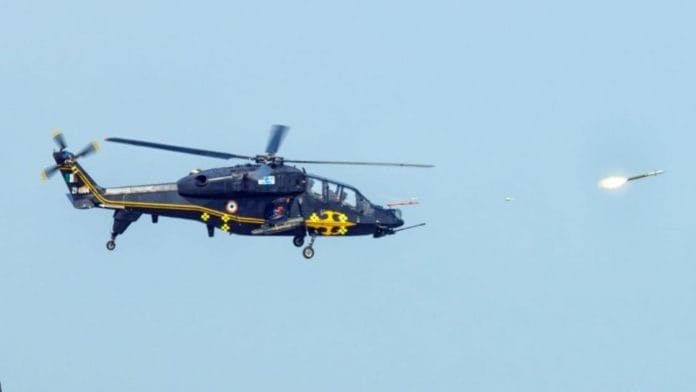The indigenous Light Combat Helicopter has been designed and developed by state-run defence manufacturer HAL.
New Delhi: The indigenous Light Combat Helicopter (LCH) has successfully completed its weapon trials, firing a Mistral air-to-air missile to destroy a moving aerial target, a first for the Indian defence establishment.
During the tests, conducted earlier this month at the integrated test range at Chandipur, Odisha, test pilots from the Hindustan Aeronautics Limited (HAL) and the Indian Air Force (IAF) executed a “flawless” mission and achieved a direct hit on the aerial target, destroying it completely, a HAL spokesperson said.
The Ministry of Defence has accorded approval for the procurement of an initial batch of 15 LCHs — 10 for the IAF and five for the Indian Army — for about Rs 2,700 core.
Great heights
HAL chairman and managing director R. Madhavan said the tests marked the first time an Indian helicopter had carried out air-to-air missile engagement.
“None of the helicopters with the military services in the country has demonstrated such a capability,” he added.
“With this, the LCH has successfully completed all weapon integration tests and is ready for operational induction,” he said.
Other weapons on the LCH include a 20mm turret gun and 70mm rockets, the firing trials of which were completed last year.
The LCH is the only attack helicopter in the world capable of operating at altitudes as high as the Siachen glacier’s, which extends to over 6,500 metres.
It has been designed and developed by Rotary Wing Research & Design Centre of HAL, the state-run defence and aerospace company.
Also read: ‘Romeo’ is just the first of hundreds of helicopters Indian military desperately needs
No target safe
As the LCH is equipped with a helmet-mounted sight, and a forward-looking infrared sighting system, pilots will be able to detect and destroy any target on the ground or in the air.
Using these, pilots can also launch a missile onto any target without having to turn the helicopter.
The fire-and-forget Mistral missile (fire-and-forget means a missile doesn’t need guidance after launch) is effective against all types of aerial threats, including unmanned aerial vehicles (UAVs) and microlight aircraft.
Capable of operating from dispersed locations and flying at ultra low levels, the LCH can provide a protective umbrella from all aerial threats.
Also read: Despite Modi’s promise, one more year passes without IAF getting its fighter jets







Like the Tejas, it is anybody’s guess when the heptr will be actually on production line. Once the order is forced upon Services, and money secured,all bets are off.
By then the world will be on drone warfare, and India still awaiting 1st heptr delivery.
That’s excellent news. But … a swallow does not announce the spring. Further success will be needed for HAL to become a key partner for the Ministry of Defense.
Let this be a “news” for Mr Modi, what an HAL product can do! Of course the PMO must have told him by now that security deposit of an ADAG company was recently encashed by Indian Navy because it could not deliver even an innocuous Coastguard Boat to them on time.
A commendable step in design of the country’s own weapons platforms.